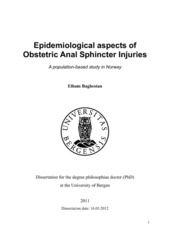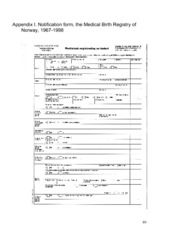| dc.contributor.author | Baghestan, Elham | en_US |
| dc.date.accessioned | 2012-04-18T08:40:52Z | |
| dc.date.available | 2012-04-18T08:40:52Z | |
| dc.date.issued | 2012-03-16 | eng |
| dc.identifier.isbn | 978-82-308-1982-1 | en_US |
| dc.identifier.uri | https://hdl.handle.net/1956/5754 | |
| dc.description.abstract | Aims: Obstetric anal sphincter injuries (OASIS) are serious complications of vaginal childbirth and may result in severe consequences such as dyspareunia, anal- and urinary incontinence. In Norway and other Scandinavian countries, the reported occurrence of these injuries has increased during the past decades. The aims of this thesis were first to validate the registration of OASIS in two Norwegian databases, the Medical Birth Registry of Norway (MBRN) and Patient Administration System (PAS). Secondly, we wanted to investigate risk factors and secular trends of OASIS in Norway in 1967-2004 and whether changes in risk factors over time could explain the trends. Thirdly, we wanted to study the obstetric history of a woman with OASIS in terms of recurrence risk, likelihood of having a subsequent delivery and mode of delivery. Finally, we wanted to assess possible familial aggregation of OASIS among relatives. Methods: All four papers are historic cohort studies. In paper I, data on OASIS cases occurring at Haukeland University Hospital during 1990-92 and 2000-02 were derived from PAS and MBRN. The registration of OASIS was validated by comparing these two registries with patient hospital records as the gold standard. Papers II-IV were population-based studies based on data from MBRN 1967-2008. We used contingency tables, logistic regression, Cox proportional hazards regression and stratification to explore associations between various exposures and outcomes, to assess interactions and to adjust for confounders. Results: The sensitivity and specificity of the MBRN database to detect OASIS were 85.3% and 99.5% in 1990–92, 91.8% and 99.7% in 2000–02, respectively. The positive and negative predictive values of OASIS in the MBRN were 91.4% and 99.1% in 1990-92 and 95.4% and 99.4% in 2000–02. The sensitivity and specificity of the PAS database were correspondingly 52.1% and 99.0% in 1990–92 and 84.6% and 98.5% in 2000–02. The positive and negative predictive values of OASIS in PAS database were 75.8% and 97.1% in 1990–92 and 92.7% and 98.9% in 2000-02. The reported occurrence of OASIS increased from 0.5% in 1967 to 4.1% in 2004. After adjustment for changes in demographic and other risk factors, the increase of OASIS persisted, although significantly reduced. OASIS were associated with maternal age 30 years or more, vaginal birth order 1, previous caesarean delivery, instrumental delivery, diabetes type 1, gestational diabetes, induction of labour by prostaglandin, large maternity units, birth weight 3,500 g or more, head circumference 35 cm or more and African or Asian women’s country of birth. Only in birth order 1 with instrumental delivery, episiotomy seemed to protect perineum against OASIS; otherwise it either increased the risk of OASIS or gave no protection against OASIS. Women with a history of OASIS in the first and the two first deliveries had four and ten fold increased risk of OASIS in the subsequent delivery, respectively. Populationattributable risk percentage of OASIS in second and third delivery due to previous OASIS was 10% and 15%, respectively. Recurrence of OASIS was high in large maternity units, in forceps delivery and with birth weight 3,500 g or more in the current delivery. However, instrumental delivery did not further increase the excess recurrence risk observed in heavy newborns. A man who fathered a child whose delivery was complicated by OASIS in one woman was more likely to father another child with OASIS delivery in another woman, if the mothers delivered at the same maternity unit. The subsequent delivery rate was not different in women with and without previous OASIS, whereas women with previous OASIS were more often scheduled to caesarean delivery. The risk of OASIS was increased two fold if a woman’s mother or sister had sustained OASIS and to a less extent if her partner’s mother or sister had sustained OASIS, and not if her brother’s partner had sustained OASIS. Conclusions: The validity of the registration of OASIS in MBRN is sufficiently high to justify epidemiological studies on OASIS based on data from this registry. The risk of OASIS increased noticeably in 1967-2004 in Norway. Changes in observed risk factors could only partially explain this increase. Most of observed risk factors such as birth order 1 and high maternal age were non-modifiable and women with such risk factors should be paid more attention at delivery for minimising their risk of OASIS. Instrumental delivery was a dominant risk factor, but the majority of OASIS cases occurred in non-instrumental vaginal deliveries. Consequently, training in both instrumental and non-instrumental deliveries with focus on reducing the speed of the birth, support of perineum and axis of birth canal should be an essential part of the national and local training programme for birth attendants. Women with a history of OASIS had a high recurrence risk in second and third delivery. Therefore, emphasis should be placed on counselling women after an initial OASIS. A history of OASIS had little or no impact on subsequent delivery rate. However, women with previous OASIS more frequently had planned caesarean delivery. Our findings in paper IV suggest that maternal and to a less extent paternal factors contribute to the risk of OASIS. The higher maternal than paternal recurrence of OASIS indicate maternal rather than paternal genetic susceptibility for OASIS. These observations must be cautiously interpreted since bias due to unmeasured confounding may have impacted the findings. | en_US |
| dc.language.iso | eng | eng |
| dc.publisher | The University of Bergen | eng |
| dc.relation.haspart | Paper I: Baghestan E, Børdahl PE, Rasmussen S, Sande AK, Lyslo I, Solvang I. A validation of the diagnosis of obstetric sphincter tears in two Norwegian databases, the Medical Birth Registry and the Patient Administration System. Acta Obstetricia et Gynecologica Scandinavica 86(2): 205-209, 2007. Full text not available in BORA due to publisher restrictions. The article is available at: <a href="http://dx.doi.org/10.1080/00016340601111364" target="blank"> http://dx.doi.org/10.1080/00016340601111364</a> | en_US |
| dc.relation.haspart | Paper II: Baghestan E, Irgens LM, Børdahl PE, Rasmussen S. Trends in risk factors for obstetric anal sphincter injuries in Norway. Obstetrics & Gynecology 116(1): 25-34, July 2010. Full text not available in BORA due to publisher restrictions. The article is available at: <a href="http://dx.doi.org/10.1097/AOG.0b013e3181e2f50b" target="blank"> http://dx.doi.org/10.1097/AOG.0b013e3181e2f50b</a> | en_US |
| dc.relation.haspart | Paper III: Baghestan E, Irgens LM, Børdahl PE, Rasmussen S. Risk of recurrence and subsequent delivery after obstetric anal sphincter injuries. BJOG: An International Journal of Obstetrics & Gynaecolog 119(1): 62–69, January 2012. Full text not available in BORA due to publisher restrictions. The article is available at: <a href="http://dx.doi.org/10.1111/j.1471-0528.2011.03150.x" target="blank"> http://dx.doi.org/10.1111/j.1471-0528.2011.03150.x</a> | en_US |
| dc.relation.haspart | Paper IV: Baghestan E, Irgens LM, Bordahl PE, Rasmussen S. Familial risk of obstetric anal sphincter injuries: registry-based cohort study. Full text not available in BORA. | en_US |
| dc.title | Epidemiological aspects of Obstetric Anal Sphincter Injuries. A population-based study in Norway | en_US |
| dc.type | Doctoral thesis | |
| dc.rights.holder | Copyright the author. All rights reserved | |
| dc.subject.nsi | VDP::Medical disciplines: 700::Clinical medical disciplines: 750::Gynecology and obstetrics: 756 | eng |

